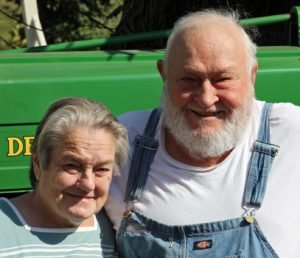AGRICULTURE ORAL HISTORY INTERVIEWS
PERRY AND ADELAIDE KRETZING
Airport Road, Kistler
Northeast Madison Township
Interviewed by Jane Hoover September 22, 2015
Perry (1935-2016) and Adelaide McMillen (b. 1938) moved to her family’s farm in 1967. They lived there at the crossroads at Kistler until their sons Vance and Allen took over the farm in 2003. They then moved around the corner to their present farm on Airport Road. Both came from Perry County farm families and they have vivid memories of farming life back into their childhood.
JANE: What kind of farm did your family have when you were in Pleasant Valley?
PERRY: It was a general farm. We had chickens, a few pigs and milked a few cows. We made butter but we didn’t sell milk. Probably grew corn, oats, wheat and hay.
ADELAIDE: Ours was a steer farm, with chickens and pigs, plus grains. We grew the grains just for our own animals, not for sale.
JANE: What changes have you seen in agriculture?
ADELAIDE: We don’t have to throw square bales around; now we have the big round bales. And the silage is much easier to do. We put most of it in the silos as haylage. You don’t have to shovel the feed around. If only Daddy could see his grandsons and how much easier it is to do it now.

JANE: When you did silage as a child, how did you do it?
PERRY: Well, I’ll go back a little further than the silo. When I was in my teen years we didn’t have a silo. Took the corn off and shocked off either with a sickle or a corn cutter, whatever you want to call them. It would sit there about a month. Then we’d go out there and husk them one at a time, by hand and the fodder we would store in shocks into the winter. We fed it to the cow. They usually ate the leaves and the husk, but they left the stalk. They didn’t like that. It went into the bedding.
When we got a silo, for a few years we still cut it off with a corn cutter and took it into the silo where we had a stationery grinder that ground it up and blew it into the silo. About 1951 they came out with a corn binder and it cut corn and tied it into bundles. We thought that was wonderful after cutting it off a sickle. And then late 1950’s a few 2-row, self-propelled forage harvesters came into the area with what they called a false end gate that pulled the sides back. You took a fork and pull it in as you pulled the sides back. It was a big savings. In the late 1960’s they came out with self-unloading forage wagons that everyone really appreciated. In our own farm about 2005, we got a self-chopper and we used two trucks and one wagon and put it right on. Nobody needs to get out of the vehicles to unload the wagons. Everything is pretty automatic. We cover about 25-30 acres of corn in an 8-hour day now, and years ago it would have taken a week or more.
JANE: What improved farm equipment or automation have you seen?
PERRY: When I was 5 or 6 years old we got the first tractor, a steel-wheeled John Deere-B. Automation and electricity came the same year. It’s hard to believe how things have changed over my 75 years farming.
JANE: So you were 5 years old; that would have been 1940 when you got the tractor?
PERRY: 1941. Electricity and tractors. Most of them in this area came in late 1930’s to19 41. During the war they didn’t make any tractors. After about 1946, they really expanded. A lot of farms had one tractor before the war. After the War, there came 2 and 3 tractors per farm.
We got milking machines in 1941, along with electricity. Before that we milked by hand. My dad gave me my first cow when I was six. He gave me an easy one that wouldn’t cause trouble.
JANE: When did you get rid of the horses and mules?
Farm at Kistler in 1975
PERRY: We had one team until early 1950’s because my dad said that in planting corn, the tractors made the ground too hard. So we used the team until about 1952, when my dad changed his mind.
JANE: What do you see in the future?
PERRY: Well I personally cannot see as many changes in the next 50 years as in the last. Sure there are going to be changes because I’ve been reading a lot about the drones and what they can do. It’s just the tip of the iceberg.
JANE: What about in land ownership?
PERRY: Everything is changed. There are a lot of single farms like there always was, but with the price of machinery, everybody farms a lot more acres. It seems as though a lot of the farms are 500 acres, well quiet a few here in western Perry county. The smaller farms have been combined. These families that have been here for years, a lot of them own two farms. Some own 5 or 6 around in this area.

